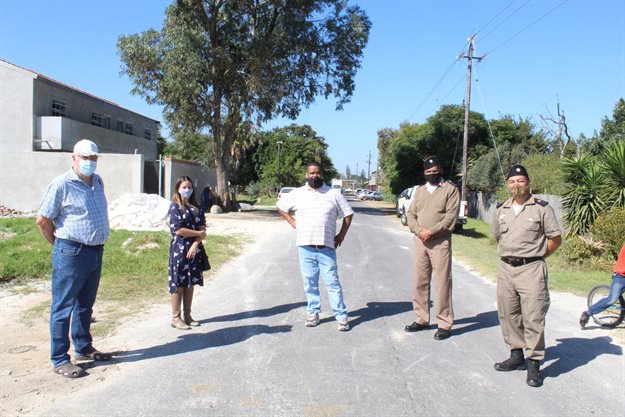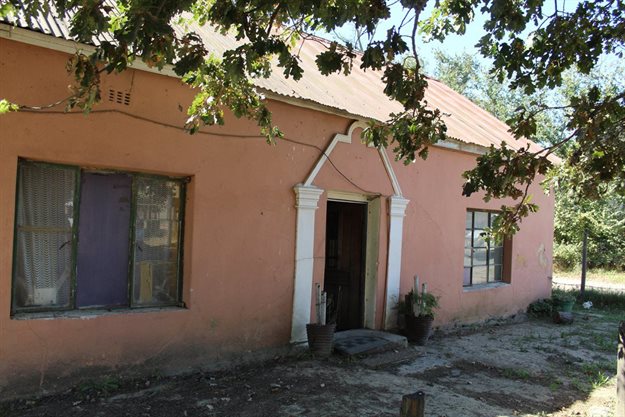Stellenbosch University (SU) aims to soon launch a social impact initiative in the Faure community to help rebuild the village and restore its natural environment. At an estimated cost of R1.5m, the project will be driven by Dr Willem de Clercq and Marlene de Witt of SU's Water Institute.

Role-players: The people involved in rebuilding Faure are from left to right, Dr Willem de Clercq, Marlene de Witt, Gen Nazeem Arnold, Brig Farouk Davids and Col Andre Mentor.
“Our aim is to rediscover this lost village situated next to the R102 highway between Somerset West and Kuils River,” explains De Clercq.
“We hope to involve the staff and students of various SU departments as well as government, the private sector and other communities to bring economic, social and environmental upliftment to Faure. We expect the project to run for approximately five years.”
The historic gem of Faure was brought to SU’s attention when members of the Cape Corps Military Veterans’ Civilian Directorate (CCMVCD) approached the Water Institute on community members’ behalf. They requested assistance to clear the Eerste River of invasive plants and fish, and restore water quality in the area, which was posing serious health risks.
When subsequently visiting the site to assess the river biodiversity and water quality, Water Institute staff immediately realised the rich historic heritage of the village and knew this would be a worthwhile intervention.
A new hope
The envisaged project will bring new hope to the CCMVCD and many residents of Faure who are concerned about the rundown environment, and the potential loss of undocumented heritage.
A descendant of some of the first residents of Faure, Gen Nazeem Arnold is grateful to the university for considering the project. “I have clear recollections of the Eerste River of my youth, and how important it was to our village,” Arnold says. “Many plants, animals and farmlands are not there anymore.” Arnold still lives in the same historic house that belonged to his ancestors and dates back to the 1700s.
Arnold proudly recalls the history of each building in the village, attending the same primary school as his great-grandparents decades before, and going to weddings in the old tea garden and to the Khoi meeting place next to the wetland.
According to De Witt, most of these stories and the history of the buildings and the community have apparently been overlooked by historians, judging by the little information that is available about the area. All that is known is that the village was named after two brothers who had farmed in the district, but no one knows why it carries their name.

Gen Nazeem Arnold’s historic house built in the 1700s.
Wooden bridge
The river was a major part of villagers’ recreational activities, and residents at the time also farmed on its banks. There appears to have been a wooden bridge across the river, of which only the stone used for its construction remains visible on the riverbank. “We believe the bridge was built by Governor Simon van der Stel, and that the Cape Dutch-style buildings date back to the mid-1700s,” says De Clercq. “Rebuilding the bridge is one of our aims.”
It is understood that the bridge was a popular meeting spot for travellers between Cape Town and Caledon, and, at the time, was the only useful link between the two towns. This is confirmed by a recent heritage impact assessment, adds De Witt. The assessment found that the land on which Faure is situated belonged to one Ferdinand Appel in 1699, who made it available as a resting place for those travelling to the Caledon hot springs.
Additional funds to be raised
The first project phase will focus on the short-term goal of empowering the community through clearing the river and the environment. While the river clearing will be funded by the university, additional funds would have to be raised for the rest of the project. To this end, De Clercq says stakeholders in government and the private sector will be approached for assistance.
It is hoped that in addition to protecting and restoring the natural environment, the project will help create economic opportunities by attracting visitors once the village has been returned to its former glory. “We believe Faure could prove to be a popular tourist attraction once the project is complete,” says Arnold. “Farming activities can then start again. And with the market and food production restored, there would hopefully be economic opportunities for the residents to make a living.”
At the same time, SU also stands to benefit from the initiative. Once the river is restored, the Water Institute would be able to extend its pollution prevention measures as well as biodiversity and water quality monitors to the Faure section of the Eerste River. Botany and zoology students would also have the chance to conduct a census of the species present in the river, on its banks and in the wetland.































